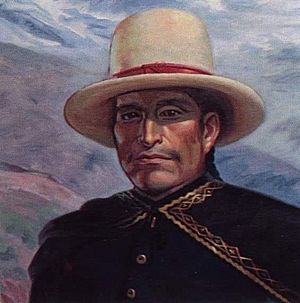Pedro Pablo Atusparía facts for kids
Quick facts for kids
Pedro Pablo Atusparía
|
|
|---|---|
 |
|
| Born | June 29, 1840 Huaraz, Ancash, Peru |
| Died | August 25, 1887 (aged 47) Huaraz, Ancash, Peru |
| Allegiance | |
| Years of service | 1885 |
| Battles/wars | Huaraz Rebellion |
| Spouse(s) |
María Fernanda Yauri
(m. 1869) |
| Children | 4 |
Pedro Pablo Atusparía Ángeles was a Peruvian politician and a champion for the rights of indigenous people. He was from the Quechua community. He became famous for leading the Huaraz Rebellion. Later, the new government of Andrés Avelino Cáceres recognized his efforts. This happened during the larger Peruvian Civil War of 1884–1885.
Contents
Early Life and Education
Pedro Atusparía was born on June 29, 1840, in Huaraz, Peru. His birth mother, María Mallqui, worked as a domestic helper. The owner of her workplace, Doña Emperatriz Sender, decided to entrust Pedro to María Martina Ángeles and Cayetano Atusparía. They became his adoptive parents and raised him.
According to local customs, indigenous children would often go to live with a "Misti" (a person of mixed European and indigenous descent). This was done to receive protection and education. Pedro was given to his godfather, Manuel Alzamora. He learned how to dye different wool fabrics. These fabrics were often sold by the Quechua people. Even with this training, Pedro remained unable to read or write for most of his life. Others signed his documents for him.
Life Before the Rebellion
Pedro Atusparía married María Fernanda Yauri on October 9, 1869. They had four children together, though their first child passed away young. By 1880, Pedro became a deputy inspector for the Marián ranch. He had a disagreement with an agent named Manuel Mosquera, which led to a physical fight.
In December 1884, an important meeting was held at a church in Huaraz. Atusparía was chosen to be the Mayor of La Independencia, a district of the city. He officially started this role in January 1885.
Impact of the War of the Pacific
After the War of the Pacific ended, the Callejón de Huaylas region faced many challenges. Chilean forces had raided and damaged the area. The Battle of Huamachuco was one of the major conflicts there. This difficult time led to the Peruvian Civil War of 1884–1885. This war was fought between the government forces of Miguel Iglesias and the rebel forces of Andrés Avelino Cáceres.
While nearby towns supported different sides, Huaraz strongly backed Iglesias. They appointed Francisco Noriega as the region's leader. However, Noriega became very unpopular. He started demanding unfair taxes and forced the Quechua people to do communal tasks.
The Huaraz Rebellion Begins
The Quechua people refused to pay the high taxes, especially the demand for four silver sols. Their opposition grew stronger. On February 22, 1885, Noriega gave them three days to pay part of the taxes. Manuel Mosquera, another leader, asked for lower taxes and an end to the forced communal tasks.
When Atusparía was ordered to make the Quechua people collect straw for roof repairs, he refused. Noriega then left the region's leadership to his assistant, José Collazos. Collazos immediately ordered the arrest of several mayors, including Atusparía. Their traditional braids were cut off, which was a great insult.
The Quechua people were very upset by this. They began planning a revolt to take over Huaraz. They wanted to punish those who supported Collazos, and free Atusparía. The rebels gathered what few weapons they had from the War of the Pacific. The siege on Huaraz began on March 2, 1885. Despite Collazos's efforts, the Quechua rebels succeeded. They freed Atusparía from prison.
Rebellion Spreads and Aftermath
Atusparía was offered the role of the new mayor of Huaraz, but he turned it down. He gave the position to Mosquera, who also opposed Iglesias. The rebellion quickly spread to other towns and the Cordillera Negra mountain range. Pedro Cochachín helped gather more political support in the area.
In response, Iglesias appointed Colonel José Iraola as the new leader. Iraola arrived with a large military force. A journalist named Luis Felipe Montestruque wrote articles claiming the Huaraz rebellion aimed to bring back the ancient Tahuantinsuyu (Inca Empire). He also suggested that Andrés Avelino Cáceres's forces might support the rebellion.
A fierce battle took place in Huaraz on May 4, 1885. Atusparía was wounded in the leg and sought safety in a house. Iraola's forces recaptured the city. Iraola promised to spare Atusparía's life if he surrendered, and Atusparía agreed. However, other Quechua leaders continued fighting, leading to more losses and the execution of a leader named Uschu Pedro.
After Cáceres defeated Iglesias in the civil war, he exiled Iglesias from Peru. One of Cáceres's first actions was to free Atusparía from prison. He invited Atusparía to the Government Palace to discuss the events in Huaraz. Cáceres acknowledged that the Quechua people had been treated unfairly.
Later Years and Legacy
Atusparía later sent his son, Manuel Ceferino, to receive a good education and be protected. On June 15, 1886, Atusparía traveled to Huaraz. Some of the remaining Quechua forces saw Atusparía as a traitor for surrendering. However, the local newspapers and positive comments from Cáceres helped improve his public image.
The exact cause of Atusparía's death is debated. Some sources say he was poisoned during a meal. However, historian Manuel Reina Loli suggests that Atusparía died from a typhus outbreak that happened around that time. He passed away on August 25, 1887.
Atusparía is remembered as a brave leader who stood up for his people's rights during a difficult time in Peruvian history.
See also
 In Spanish: Pedro Pablo Atusparia para niños
In Spanish: Pedro Pablo Atusparia para niños

